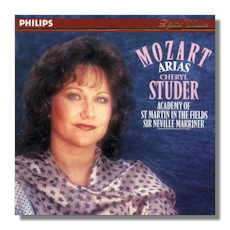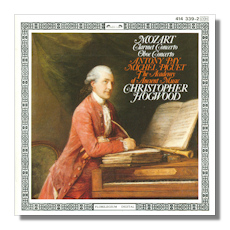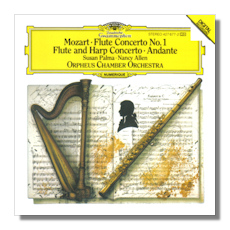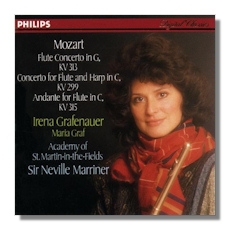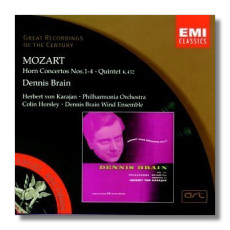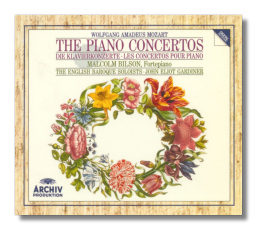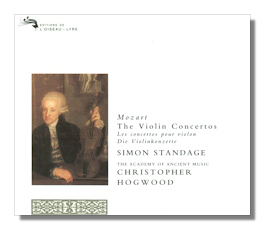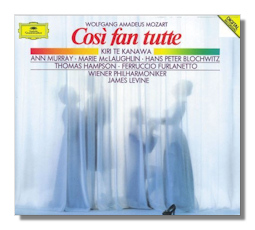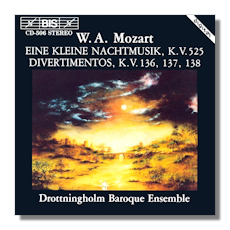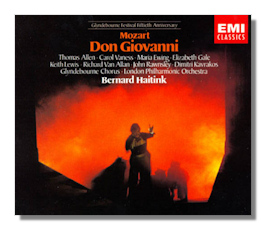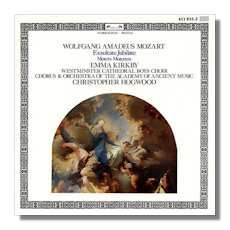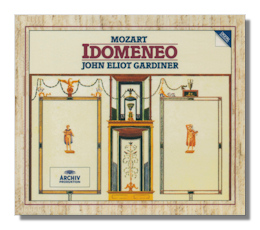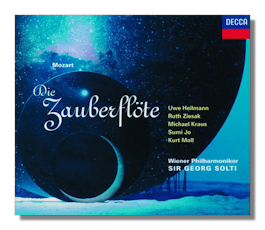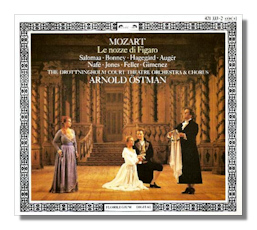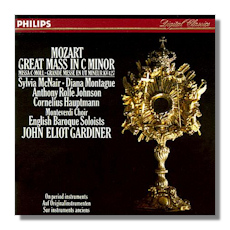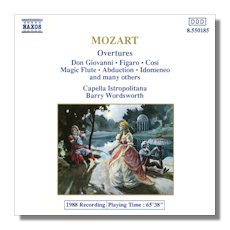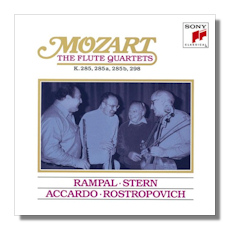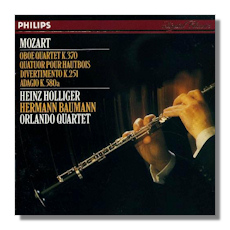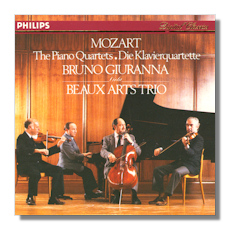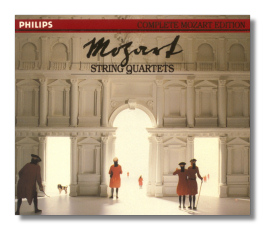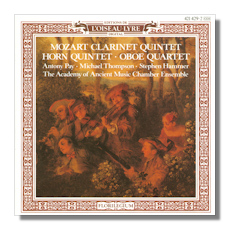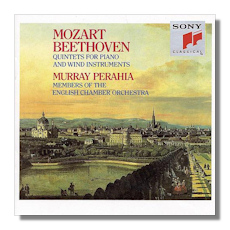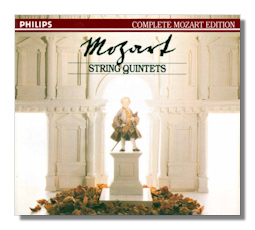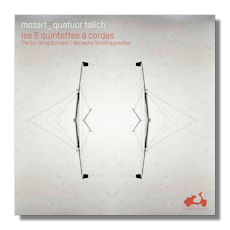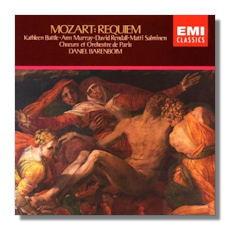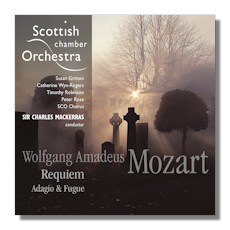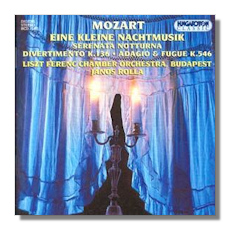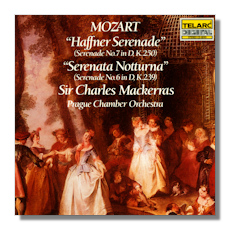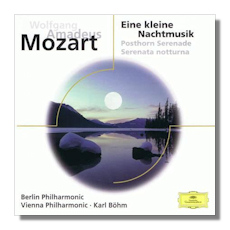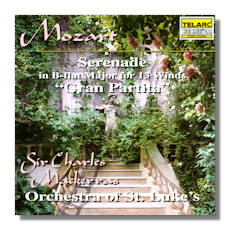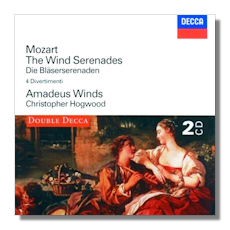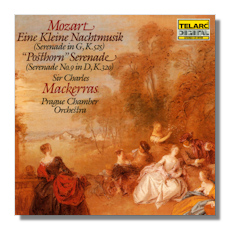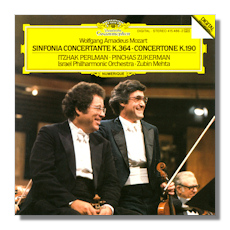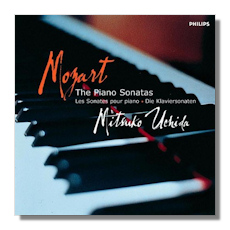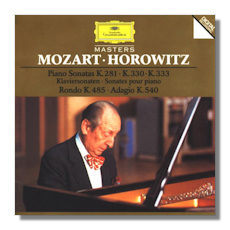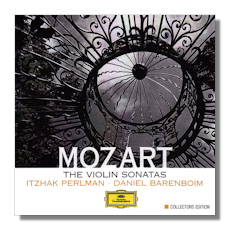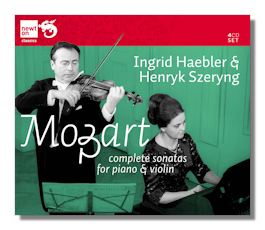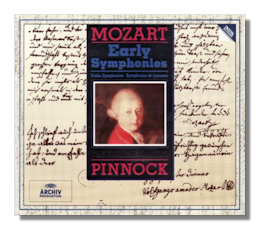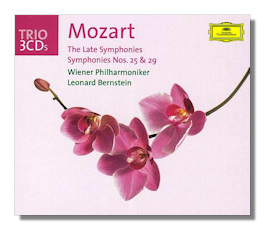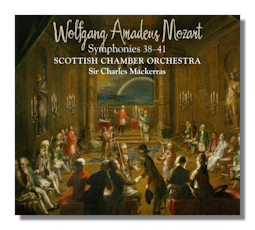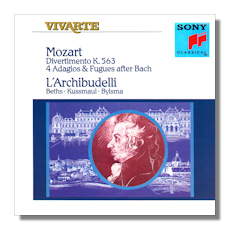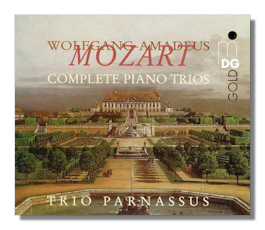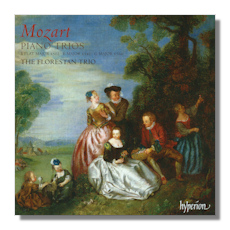
The Internet's Premier Classical Music Source
Related Links
- Recommended Recordings
Recommended Biographies
Recommended Scores
CD / DVD Reviews - Mozart Works List
by Dave Lampson - Mozart's Arrangement of Handel's Messiah
by Teri Noel Towe - Audio Samples:
 (MIDI)
(MIDI) - Serenade #13 "Eine kleine Nachtmusik", K. 525 ( I - II - III - IV )
- Overture from The Marriage of Figaro
- Queen of the Night aria from The Magic Flute
- Confutatis from the Requiem
- A Musical Joke, K. 522 ( I )
-
Find CDs & Downloads
Amazon - UK - Germany - Canada - France - Japan
ArkivMusic - CD Universe
Find DVDs & Blu-ray
Amazon - UK - Germany - Canada - France - Japan
ArkivMusic-Video Universe
Find Scores & Sheet Music
Sheet Music Plus -
- Mozart Works List
by Petter Holmqvist - Wolfgang Amadeus Mozart
by Tom Ziegler - Offenbacher Mozart Collection
University of Washington - Wolfgang Amadé Mozart
by Joan Staels - Mozart's Place
Recommended Links
Site News
Wolfgang Amadé Mozart
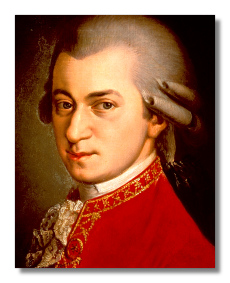
(1756 - 1791)
Like J.S. Bach, Mozart (January 27, 1756 - December 5, 1791) had little interest in establishing new forms within Classical music: he was more committed to the idea of synthesis and the perfection of forms already in existence. Thus it is only in the area of the concerto that he could be said to have moved the music forward in any substantial way. However, again like Bach, the supreme quality he brought to previously defined forms places him in the front rank of musical geniuses.
Baptized Johannes Chrysostomus Wolfgangus Theophilus, Mozart was the seventh-born child of a musically gifted and personally ambitious father, Leopold, the son of an Augsburg bookbinder. By dint of his determined character, Leopold eventually attained the positions of Court composer and vice-Kapellmeister to the Salzburg establishment of Count Thurn und Taxis, Canon of Salzburg. Leopold was an able composer, and his "Toy Symphony" is still regularly performed, but the accomplishment most admired during his lifetime was a treatise on violin playing published in 1756, the year of Wolfgang's birth.
Both Wolfgang and his elder sister, Maria Anna (nicknamed Nannerl), were child prodigies. Wolfgang was given lessons by his father from the age of four, and within a year he was not only playing duets with his sister, but composing little minuets in imitation of the pieces his father set him. His progress continued to be prodigious and by early 1762 Leopold believed the two children were ready to be introduced to the world. All three Mozarts were presented at the Court of the Elector of Munich and later in the same year their burgeoning reputations led to an appearance at the Emperor's Viennese Court at Schönbrunn Palace, where little Wolfgang's talent and artless behavior (which included jumping into the Empress's lap and kissing her) made him the object of everyone's indulgence.
Over the next few years the Mozart family followed a pattern of increasingly ambitious tours to various cities throughout Europe, including Paris, London, Amsterdam, Utrecht and Munich, as well as giving concerts to the aristocracy of Salzburg and Vienna. Another pattern which emerged from the tours, however, was not so propitious: the regular illnesses suffered by all the family, but by the two children in particular. It has since been speculated that these illnesses had a generally weakening effect on the boy's constitution, leaving him vulnerable in later life, although Nannerl outlived Wolfgang by 28 years.
In 1768, and by imperial command, Wolfgang composed a full-length opera, La finta semplice (The Simple Pretense, K. 51) to words by Coltellini, and also saw a private production of his short operatic work Bastien und Bastienne (K. 50). He was now aged 12. An extended tour of Italy (1769-71) by father and son met with unprecedented success: Wolfgang was given a private audience with the Pope in Rome and was awarded the Order of the Golden Spur. In Bologna he was admitted to the ranks of compositore by the Accademica Filarmonica – a position normally denied to anyone under 20. At this stage Wolfgang was still very much a child, writing to his sister from Milan:
"Lest you should think I am unwell I am sending you these few lines. I kiss Mamma's hand. My greetings to all our good friends. I have seen four rascals hanged here in the Piazza del Duomo. They hang them just as they do in Lyon. Wolfgang".
Less than a year after their return to Salzburg (where Wolfgang was again seriously ill) the Mozarts were back in Milan where the opera Lucia Silla (K. 135) was completed. Austria beckoned once more, and a Viennese visit in the late spring of 1773 brought Mozart into contact with the work of Franz Joseph Haydn, specifically his String Quartets Op. 20, the so-called "Sun" Quartets, from which Mozart later claimed to have learned vital lessons in form and development.
The Munich Carnival of 1775 prompted a commission for a new opera; the result was La finta giardiniera (K. 196), which made a deep impression on the German composer Christian Friedrich Daniel Schubart, a wild and dissipated man but a great judge of musical talent, who commented: "Unless Mozart should prove to be a mere overgrown product of the forcing-house, he will be the greatest composer that ever lived".
Now approaching the end of his teenage years, Mozart was committed to composing in the fashionable style of the time, the "gallant" style, which emphasized brilliance and display and which would keep him enthralled for at least the next two years. He was also kicking at the boundaries of life in Salzburg, a city which, for all its pride in its cultural accomplishments, was deeply parochial. For Mozart, who had already seen the most sophisticated cities in Europe, this must have been doubly hard to bear, especially when his father's employer at the Cathedral, Archbishop Colloredo, was utterly out of sympathy with his aims and outlook on life.
In September 1777 Mozart left for Paris with his mother, leaving Leopold and Nannerl in Salzburg: the tour was to be financed solely by fees earned while traveling. The pair had reached Mannheim when an event occurred that decisively shaped his future: Wolfgang fell in love with Aloysia, the second daughter of the impecunious prompter and copyist, Fridolin Weber. As the girl, who was a talented singer, returned his affections, Mozart hatched a hare-brained scheme to take her to Italy and make her a prima donna. He wrote to his father to inform him but Leopold saw only catastrophe ahead; after a series of bullying and wheedling letters, he eventually persuaded Wolfgang out of the idea.
Mozart and his mother finally arrived in Paris in March 1778, but she was ill on arrival; her condition worsened and in early July she died in Mozart's arms. The distraught son remained sensitive to his father's feelings throughout this terrible experience, asking a mutual friend to prepare Leopold for bad news before writing to him himself. In a letter to a friend, Mozart wrote:
"She was constantly delirious, and today at twenty-one minutes past five o'clock the death agony began and she lost all sensation and consciousness. I pressed her hand and spoke to her, but she did not see me, did not hear me and all feeling was gone".
He left Paris soon after, traveling back via Munich, now the home of the Weber family, but Aloysia had married and affected to retain no feelings for him. By January 1779 he was back in Salzburg where he took up the position of Konzertmeister to the Court and Cathedral. His life had irreversibly altered.
A brief and pleasant interlude in Munich, which included the premiere at the 1781 Munich Carnival of Idomeneo, Re di Creta (Idomeneo, King of Crete, K. 367) – one of his greatest opera serias – was brought to a close by an urgent summons from the Salzburg Archibishop for Wolfgang to join his party in Vienna. He was treated by the Archbishop as a possession, shown off to the aristocracy of Vienna but made to eat and live with the domestic servants. Mozart's anger over his employer's arrogant attitude led to a row and subsequently to Mozart being literally kicked out of the Archibishop's residence, pursued by a string of expletives from his secretary, Count Arco. Braving his father's anger, Wolfgang refused to attempt a reconciliation knowing that the time for such things was past. He had high hopes for an independent career in Vienna.
Leopold's anger turned to paroxysm of rage when Wolfgang moved into lodgings in Vienna with the Weber family with whom he had had such curious relations in Mannheim a few years previously. Herr Weber had died, leaving the family relatively poor. Wolfgang now fell for the third sister, Constanze. Young and still gullible, he was put under pressure by Constanze's mother and agreed to sign a marriage contract of intent, nearly driving Leopold to distraction, but by now his son's mind was fixed. Amidst the chaos of his personal life, Mozart enjoyed the successful premiere of Die Entführung aus dem Serail (K. 384), and in all probability met Haydn for the first time in the late autumn of 1781, when the older man was visiting Vienna. From the beginning the admiration between the two composers was mutual. Mozart was only 26 while Haydn was nearly 50, but both learned a good deal from each other, Mozart in the realm of structure and expressive dignity, Haydn in colorization and richer melody.
The year 1782 began with a series of subscription concerts for which Mozart often prepared new piano concertos or symphonies, and which were regularly attended by the Austrian nobility, but the hoped-for Court appointments failed to materialize. When he and Constanze finally married late that summer (against the wishes of his father and sister), the newly-married couple looked forward to a precarious existence, sustained in part by private music lessons, for which Mozart was singularly ill-suited. The first child arrived the following summer, and in 1783 Mozart and his wife visited Leopold in Salzburg. But the relationship between father and son could never be the same, even though Leopold returned the visit in 1785. This was to be their last meeting, and was fortunately a happy one: Leopold met Mozart's friend Haydn and was told by the older composer that Wolfgang had "the most consummate knowledge of the art of composition". The father's return to Salzburg was accompanied by ill-health, and he was dead within two years.
Another major development in Mozart's life began when he joined the Freemasons, a powerful secret society. This was no passing fancy on Mozart's part, as was demonstrated by the constant undertone of Masonic thought which can be traced in so many of the works composed in his remaining years. A more artistically important event occurred in 1785 when Mozart became acquainted with the newly-appointed Imperial Court Poet, the Jewish Italian Lorenzo da Ponte. He invited da Ponte to compose a libretto, and together they created Le nozze di Figaro (K. 492) based on Beaumarchais' anti-establishment satire. Produced in Vienna on the first day of May 1786, after surviving vicious Court intrigues against it, the opera became the hit of the season. A subsequent production in Prague (to which Mozart was invited) was an even greater success, and Mozart wrote to a friend:
"Here they talk about nothing but Figaro. Nothing is played, sung or whistled but Figaro. No opera is drawing like Figaro. Nothing, nothing but Figaro. Certainly a great honour for me!"
Before leaving Prague Mozart was commissioned by a local entrepreneur to provide a new opera for the following season: the result was his next collaboration with da Ponte, Don Giovanni (K. 527). This was given its premiere in Prague in October 1787 and was a fantastic success; Mozart was given a trumpet fanfare even as he arrived at the theater. But even with such public acclaim, the composer was by no means financially secure; as copyright did not yet exist in the theater, he had nothing to show for his operatic triumphs but the initial fee paid to him. Compounded by their unworldly approach to domestic economy the Mozarts were constantly on the edge of a financial crisis, alleviated only by the generosity of friends or the occasional windfall of some profitable concert or commission.
The composer Gluck's death in November 1787 cleared the way for a long-overdue appointment to the Emperor's Court, although only as Kammercompositor, which came with a paltry salary; Mozart could hardly conceal his contempt when writing to accept the offer. Around the same time his letters reveal that he was borrowing consistently from a Masonic colleague, the wealthy merchant Michael Puchberg. Despite being in desperate financial need, the quality of Mozart's artistic output is staggeringly consistent – it was at this time that he completed his last three symphonies, including the most famous of all, the Jupiter (K. 551).
With no alleviation of his condition, in 1786 he accepted the invitation of his friend and pupil Prince Karl Lichnowsky to travel with him to Berlin with the object of playing at the Court of Frederick William II. The tour was a considerable success, with Mozart being well-received in towns along the route. He also managed to please the King enough to be commissioned to write a series of quartets. Yet he returned to Vienna in early summer with little money, and was immediately plunged back into the familiar cycle of penury and his wife's constant ill-health (perhaps resulting from her almost perpetual state of pregnancy). The Emperor commissioned a new opera, for which Mozart once again collaborated with da Ponte, the result, Cosí fan tutte (All Woman do so, K. 586), had a short but successful run in 1790 before being suspended due to the death of the Emperor. The bad timing which had dogged Mozart for so much of the 1780s seemed set to continue. The new Emperor; Leopold II, cared little for music or for the advancement of an insignificant commoner like Mozart. Wolfgang's attempts to improve his position at Court only resulted in an agreement that he should become Kapellmeister at St Stephen's Cathedral on the death of the incumbent, Hoffman. Needless to say, Hoffman outlived him.
A tour of parts of Germany in autumn 1790 was Mozart's last (he had consistently turned down offers of tours in England), and he had to pawn the family silver to mount it. In Munich, he appeared at the Elector's Court before the King of Naples, who was a member of the Hapsburg dynasty – a cruel irony for Mozart who had been denied the opportunity of playing to the King in Vienna. As he commented: "It is greatly to the credit of the Viennese Court that the King has to hear me in a foreign country".
By now Mozart was showing signs of fatigue and illness which proved permanent. His phenomenal rate of composition had slowed markedly in 1790, and it was only through a supreme effort of will that he raised his creative tempo again in 1791. A commission from an old friend, Emmanuel Schikaneder, to write music to a libretto of his, gradually evolved into the sublime Die Zauberflöte (K. 620), a work with strong Masonic imagery throughout as well as an unending supply of immortal melodies. It was premiered at a theater in the grounds of Prince Starhemberg's house in the Viennese suburb of Wieden in the same month that his last opera seria, La Clemenza di Tito (The Clemency of Titus, K. 621), was given its premiere at the National Theatre in Prague on the eve of the coronation of the new emperor.
Mozart's last months were spent in a spiral of increasing illness, financial worries and a rising fear that he would not complete his final commission – his Requiem (K. 626). This had been requested by a messenger who refused to divulge either his own name or that of the patron who wanted the work. Mozart became convinced that the messenger had been other-worldly, and that he was composing his own requiem. The truth was more prosaic: the Viennese nobleman Count Franz Walsegg-Stuppach who commissioned it was in the practice of commissioning works from established composers, recopying them in his own hand, and then passing them off as his own to his friends. This was not to be the case with Mozart, as he left the work uncompleted at his death, his last days largely taken up with detailed instructions to his friend and acolyte Franz Xaver Süssmayr as to how it should be completed after his death.
Mozart died in December 1791, aged just 36, his funeral service held in the open air at St. Stephen's Cathedral. With a violent snowstorm raging, the coffin was taken in the pallbearer's wagon unaccompanied to a common graveyard, where, as was a common practice in the day, Mozart's body was consigned to an unmarked grave: a fitting epitaph to his life in Vienna.
During his short life, Mozart wrote sublimely for every known musical form, creating a vast array of masterpieces both great and small. Of the 23 original piano concertos (the first four are arrangements of works by other composers), the works from the Concerto #11 in F Major (K. 413) of 1782 onwards are generally regarded as completely mature, exhibiting a wholly remarkable balance between melody and harmony, soloist and orchestra. The soloist is a leader amongst equals and the listener can be forgiven for feeling he is in a musical heaven when these works are played by the right musicians.
The flute/oboe concertos (K. 313/314) have been particularly popular in recent years, as has been the Concerto for Flute and Harp (K. 299), and the four bravura horn concertos – written, it would seem, with the intent of testing the soloist – have never ceased to be in demand. But perhaps the most fully-realized of all the wind concertos is the late Concerto for Clarinet in A (K. 622), written in 1791 and exhibiting Mozart's deep love of the instrument. It explores the instrument's range and tonal qualities so successfully as to be a complete exposition of its musical qualities within the Classical style. The five violin concertos come from his Salzburg period and, while offering plenty to enjoy, lack the depth of his later concertos.
As far as the symphony is concerned, there is little reason initially to go beyond the last four (#38-41), all written in 1786, to find the perfect introduction to all the greatest qualities his symphonies can exhibit. Each is written in a contrasting manner and mood to the other, and each in its own way represents a summation of style and content which repays years of study. Of the numerous serenades, nocturnes, dances and marches, the former group represents the most substantial musical contribution, but each grouping brings its own felicities; the dances and marches, for example, have such a degree of élan and skill that they give much pleasure to the listener not looking for the utmost profundity. The two famous serenades, Eine kleine Nachtmusik (K. 525) and Gran Partita (K. 361) are irresistible.
Mozart's achievement in every area of classical music is staggering; it would be unwise, therefore, to overlook either his chamber music or his keyboard music, although no-one would claim for the keyboard sonatas the pre-eminent place enjoyed by his successor, Beethoven, in this field. Of the chamber music, the two marvelous String Quintets, (K. 515 and 516), are unsurpassable in their own very different ways, while the Clarinet Quintet (K. 581) has the warmth and dexterity of its concerted equivalent plus a special intimacy endemic to the smaller forces. Of the string quartets, those dedicated to Haydn (the six quartets K. 387, 421, 428, 458 "Hunt", 464 & 465 "Dissonance"), written between 1783 and 1785, are the most famous and frequently performed. They show both his great debt to Haydn and his complete ease with the quartet format.
Finally, the vocal works: of a vast quantity written for religious occasions, the unfinished Requiem (K. 626) is by far the most famous, and stands as one of his supreme creations. Also popular are the Coronation Mass (K. 317) and the C minor Mass (Great, K. 427), while the beautiful Exsultate, jubilate (K. 165) and Ave verum corpus (K. 618) are a favorite with singers and represent Mozart at his most affecting. Also not to be overlooked is the aptly named Vesperae solennes de confessare (K. 339). Of the operas, the essential works if a listener is to grasp the range and depth of Mozart's theatrical genius would have to include all three da Ponte operas (Le nozze di Figaro, Don Giovanni and Cosí fan tutte), Die Zauberflöte and quite probably the delightful Die Entführung aus dem Serail. Some would also claim a place for Idomeneo and La Clemenza di Tito, but these fine examples of the opera seria form are something of an acquired taste for a modern audience. They are best arrived at after a thorough assimilation of the five works mentioned above.

Recommended Recordings
Arias 
Sheet Music for these Pieces
- 9 Opera Arias for Tenor/Arabesque Z6598
-
Rockwell Blake (tenor), Nicholas McGegan/London Symphony Orchestra
- 7 Opera Arias for Soprano/Philips 426721-2
-
Cheryl Studer (soprano), Neville Marriner/Academy of St. Martin-In-The-Fields
- 7 Concert Arias/London 417756-2
-
Kiri Te Kanawa (soprano), Gyorgy Fischer/Vienna Chamber Orchestra
- Opera & Concert Arias/London 430513-2
-
Cecilia Bartoli (soprano), András Schiff (piano), Gyorgy Fischer/Vienna Chamber Orchestra
Concerto for Clarinet
Sheet Music for this Piece
- Clarinet Concerto in A Major, K. 622; Oboe Concerto/L'Oiseau-Lyre 414339-2
-
Anthony Pay (basset clarinet), Christopher Hogwood/Academy Of Ancient Music
- Clarinet Concerto in A Major, K. 622; Oboe Concerto/Delos D/CD3020
-
David Shifrin (clarinet), Gerard Schwarz/Mostly Mozart Orchestra
- Clarinet Concerto in A Major, K. 622; Oboe Concerto/Hyperion CDA66199
-
Thea King (basset clarinet), Jeffrey Tate/English Chamber Orchestra
- Clarinet Concerto in A Major, K. 622; Oboe Concerto/Philips 420710-2
-
Jack Brymer (clarinet), Colin Davis/London Symphony Orchestra
 Concertos for Flute/Oboe
Concertos for Flute/Oboe
Sheet Music for this Piece
- Flute Concerto #1 in G Major, K. 313; Concerto for Flute & Harp; Andante/Deutsche Grammophon 426677-2
-
Susan Palma (Flute)/Orpheus Chamber Orchestra
- Flute Concerto #1 in G Major, K. 313; Concerto for Flute & Harp; Bassoon Concerto/L'Oiseau-Lyre 417622-2
-
Lisa Beznosiuk (flute), Christopher Hogwood/Academy Of Ancient Music
Amazon - UK - Germany - Canada - France - Japan - ArkivMusic
Or reissued as L'Oiseau-Lyre 4780021
ArkivMusic - CD Universe - JPC - Flute Concertos #1 & 2, K. 313 & 314; Concerto for Flute & Harp/EMI 85195-2
-
Emmanuel Pahud (flute), Claudio Abbado/Berlin Philharmonic Orchestra
- Flute Concerto #1 in G Major, K. 313; Concerto for Flute & Harp; Andante/Philips 422339-2
-
Irena Grafenauer (flute), Neville Marriner/Academy of St. Martin-In-The-Fields
- Flute Concerto #2 in C Major, K. 314 w/ Mercadante & C. Stamitz/Philips 426318-2
-
Irena Grafenauer (flute), Neville Marriner/Academy of St. Martin-In-The-Fields
- Oboe Concerto in C Major, K. 314; Clarinet Concerto/L'Oiseau-Lyre 414339-2
-
Michel Piguet (oboe), Christopher Hogwood/Academy Of Ancient Music
- Oboe Concerto in C Major, K. 314 w/ Krommer/Hyperion CDA66411
-
Sarah Francis (oboe), Howard Shelley/London Mozart Players
 Concertos for Horn #1-4, K. 412, 417, 447 & 495
Concertos for Horn #1-4, K. 412, 417, 447 & 495
Sheet Music for this Piece
- 4 Horn Concertos, K. 412, 417, 447 & 495, Quintet for Piano & Winds, K. 452/EMI Angel 66950 Mono
-
Dennis Brain (horn), Herbert von Karajan/Philharmonia Orchestra
Amazon - UK - Germany - Canada - France - Japan - ArkivMusic - CD Universe
Or reissued on EMI 38603-2
Amazon - UK - Germany - Canada - France - Japan - ArkivMusic - CD Universe - JPC
Or EMI 678328-2
Amazon - UK - Germany - Canada - France - Japan - ArkivMusic - CD Universe - JPC - 4 Horn Concertos, K. 412, 417, 447 & 495; Rondo K. 371/Pentatone SACD PTC5186105
-
Alan Civil (horn), Neville Marriner/Academy of St. Martin in the Fields
- 4 Horn Concertos, K. 412, 417, 447 & 495/Philips 412737-2
-
Hermann Baumann (horn), Pinchas Zukerman/Saint Paul Chamber Orchestra
- 4 Horn Concertos, K. 412, 417, 447 & 495; Rondo K. 371/CBS MDK44906
-
Dale Clevenger (horn)/Liszt Chamber Orchestra
 Concertos for Piano (7-19,
Concertos for Piano (7-19,  20,
20,  21,
21,  23, 24, 25, 27)
23, 24, 25, 27)
Sheet Music for this Piece
- 23 Piano Concertos, #5-27/Archiv 431211-2 9CDs
-
Malcolm Bilson, Robert Levin & Melvyn Tan (fortepianos), John Eliot Gardiner/English Baroque Soloists
- 25 Piano Concertos, #1-6, 8, 9, 11-27/Deutsche Grammophon 429001-2 8CDs
-
Géza Anda (piano)/Salzburg Mozarteum Camerata
- 27 Piano Concertos, #1-27/Sony-CBS 87230 12CDs
-
Murray Perahia, Radu Lupu (pianos)/English Chamber Orchestra
- 21 Piano Concertos, #5, 6, 8, 9 11-27/Philips 4757306 8CDs
-
Mitsuko Uchida (piano), Jeffrey Tate/English Chamber Orchestra
- 2 Piano Concertos, #24 & 25/London 425791-2
-
András Schiff (piano), Sándor Végh/Camerata Academica des Mozarteums Salzburg
Concertos for Violin (#3-5)
Sheet Music for this Piece
- 5 Violin Concertos #1-5, Rondos K. 268 & 373 and Adagio K. 261/L'Oiseau-Lyre 433045-2
-
Simon Standage (violin), Christopher Hogwood/Academy Of Ancient Music
- 5 Violin Concertos #1-5, Rondos K. 268 & 373 and Adagio K. 261/Naxos 8.503002
-
Takako Nishizaki (violin), Stephen Gunzenhauser & Johannes Wildner/Capella Istropolitana
Amazon - UK - Germany - Canada - France - Japan - ArkivMusic - CD Universe - JPC
Or Available separately -
Concertos #1 & 2 on Naxos 8.550414
Amazon - UK - Germany - Canada - France - Japan - ArkivMusic - CD Universe - JPC
Concertos #3 & 5 on Naxos 8.550418
Amazon - UK - Germany - Canada - France - Japan - ArkivMusic - CD Universe - JPC
Concerto #4 & Sinfonia concertante, K. 364 on Naxos 8.550332
Amazon - UK - Germany - Canada - France - Japan - ArkivMusic - CD Universe - JPC - 5 Violin Concertos #1-5; Violin Sonatas, K. 454 & 526/Philips 464722-2
-
Arthur Grumiaux (violin), Colin Davis/London Symphony Orchestra
- 2 Violin Concertos #3 & 5/Deutsche Grammophon 457746-2
-
Anne-Sophie Mutter (violin), Herbert von Karajan/Berlin Philharmonic Orchestra
- 2 Violin Concertos #1 & 4/CBS MK44503
-
Cho-Liang Lin (violin), Raymond Leppard/English Chamber Orchestra
Cosí fan tutte (opera)
Sheet Music for this Piece
- Cosí fan tutte, K. 588/Deutsche Grammophon 423897-2
-
Kiri Te Kanawa (soprano), Ann Murray (mezzo-soprano), Marie McLaughlin (soprano), Hans-Peter Blochwitz (tenor), Thomas Hampson (bass-baritone), Feruccio Furlanetto (bass), James Levine/Vienna Philharmonic Orchestra & State Opera Chorus
- Cosí fan tutte, K. 588/Archiv 437829-2
-
Amanda Roocroft (soprano), Rosa Mannion (mezzo-soprano), Eirian James (soprano), Rainer Trost (tenor), Rodney Gilfry (baritone), Carlos Feller (bass), John Eliot Gardiner/English Baroque Soloists & Monteverdi Choir
- Cosí fan tutte, K. 588/Opus Arte DVD OA0970D
-
Ainhoa Garmendia (soprano), Anke Vondung (mezzo soprano), Luca Pisaroni (bass baritone), Nicolas Rivenq (baritone), Topi Lehtipuu (tenor), Miah Persson (soprano), Iván Fischer/Orchestra of the Age of Enlightenment, Glyndebourne Festival Chorus
Amazon - UK - Germany - Canada - France - Japan - ArkivMusic - CD Universe - JPC
Or also available on Blu-ray OABD7035D:
Amazon - UK - Germany - Canada - France - Japan - ArkivMusic - CD Universe - JPC
 Divertimentos (
Divertimentos ( #1-3 &
#1-3 &  #10)
#10)
Sheet Music for this Piece
- 3 Divertimentos #1-3, K. 136-138, Serenade #6 "Serenata Notturna", K. 239 and Serenade #13 "Eine kleine Nachtmusik", K. 525/Philips 420712-2
-
I Musici
- 3 Divertimentos #1-3, K. 136-138 and Serenade #13 "Eine kleine Nachtmusik", K. 525/BIS CD-506
-
Drottningholm Baroque Ensemble
- 2 Divertimentos #10, K. 247 & #17 K. 334/Sony Vivarte SK46494
-
L'Archibudelli
- 4 Divertimentos K. 166, 186, 226 & 227/Orfeo C163881A
-
Berlin Philharmonic Winds
- 6 Divertimentos #8, 9, 12-14 & 16, K. 213, 240, 252, 253, 270 & 289/Accent ACC8856D
-
Octophoros
 Don Giovanni (opera)
Don Giovanni (opera)
Sheet Music for this Piece
- Don Giovanni, K. 537/EMI CDS7470372
-
Thomas Allen (baritone), Carol Vaness (soprano), Maria Ewing (mezzo-soprano), Elizabeth Gale (soprano), Bernard Haitink/London Philharmonic Orchestra & Glynebourne Chorus
- Don Giovanni, K. 537/EMI CDS7472602
-
Eberhard Wächter (baritone), Joan Sutherland (soprano), Elisabeth Schwarzkopf (soprano), Graziella Sciutti (soprano), Carlo Maria Giulini/Philharmonia Orchestra & Chorus
Amazon - UK - Germany - Canada - France - Japan - ArkivMusic - CD Universe
Or reissued on EMI 556232-2
Amazon - UK - Germany - Canada - France - Japan
Or reissued on EMI Great Recordings of the Century 67873-2
Amazon - UK - Germany - Canada - France - Japan - ArkivMusic
Or reissued on EMI 66799-2 w/ CD-ROM Libretto
Amazon - UK - Germany - Canada - France - Japan - ArkivMusic - CD Universe - JPC - Don Giovanni, K. 537/Teldec 2292-44184-2
-
Thomas Hampson (bass-baritone), Robert Holl (bass), Edita Gruberová (soprano), Hans-Peter Blochwitz (tenor), Nicholas Harnoncourt/Royal Concertgebouw Orchestra & Netherlands Opera Chorus
 Exsultate, Jubilate (motet)
Exsultate, Jubilate (motet)
Sheet Music for this Piece
- Exsultate, Jubilate, K. 165 (158a); Regina coeli in C Major, Ergo interest, Regina coeli in B Flat Major/L'Oiseau-Lyre 411832-2
-
Emma Kirkby (soprano), Christopher Hogwood/Academy of Ancient Music & Westminster Cathedral Boy's Choir
- Exsultate, Jubilate, K. 165 (158a); Laudate Dominum, Kyrie in D minor, Ave verum corpuste/Philips 412873-2
-
Kiri Te Kanawa (soprano), Colin Davis/London Symphony Orchestra & Chorus
- Exsultate, Jubilate, K. 165 (158a); Coronation Mass, Ave verum corpus, Missa brevis in F Major/Chandos Chaconne CHAN0786
-
Susan Gritton (soprano), Andrew Nethsingha/Cambridge St. John's College Choir, St John's Sinfonia
Idomeneo (opera)
Sheet Music for this Piece
- Idomeneo, re di Creta, K. 366/Archiv 431674-2
-
Anthony Rolfe Johnson (tenor), Anne-Sophie van Otter (soprano), Jonathan Peter Kenny (Countertenor), Sylvia McNair (mezzo-soprano), Hillevi Martinpelto (soprano), John Eliot Gardiner/English Baroque Soloists & Monteverdi Choir
- Idomeneo, re di Creta, K. 366/Teldec 2292-42600-2
-
Werner Hollweg (bass-baritone), Felicity Palmer (soprano), Kurt Equiluz (tenor), Trudeliese Schmidt (mezzo soprano), Rachel Yakar (soprano), Robert Tear (tenor), Nicholas Harnoncourt/Mozart Orchestra & Zurich Opera House Chorus
 Die Zauberflöte "The Magic Flute" (opera)
Die Zauberflöte "The Magic Flute" (opera) 
Sheet Music for this Piece
- Die Zauberflöte, K. 620/London (Decca) 433210-2
-
Sumi Jo (soprano), Ruth Ziesack (soprano), Uwe Heilmann (tenor), Kraus, Kurt Moll (bass), Georg Solti/Vienna Philharmonic Orchestra & State Opera Orchestra
- Die Zauberflöte, K. 620/Deutsche Grammophon 435395-2
-
Roberta Peters (soprano), Evelyn Lear (soprano), Lisa Otto (soprano), Fritz Wunderlich (tenor), Dietrich Fischer-Dieskau (baritone), Franz Crass (bass), Karl Böhm/Berlin Philharmonic Orchestra & RIAS Chamber Chorus
- Die Zauberflöte, K. 620/Teldec 2292-42716-2
-
Edita Gruberová (soprano), Hans-Peter Blochwitz (tenor), Barbara Bonney (soprano), Thomas Hampson (bass-baritone), Nicholas Harnoncourt/Zurich Opera House Orchestra & Chorus
- Die Zauberflöte, K. 620/EMI Classics 66793-2
-
Gerhard Unger (tenor), Gundula Janowitz (soprano), Walter Berry (tenor), Christa Ludwig (mezzo soprano), Lucia Popp (soprano), Elisabeth Schwarzkopf (soprano), Nicolai Gedda (tenor), Otto Klemperer/Philharmonia Orchestra & Chorus
Marriage of Figaro (opera) 
Sheet Music for this Piece
- Le nozze di Figaro, K. 492/L'Oiseau-Lyre 421333-2
-
Barbara Bonney (soprano), Arleen Augér (soprano), Alicia Nafé (mezzo-soprano), Petteri Salomaa (bass), Håkan Hagegård (baritone), Arnold Östman/Drottningholm Court Theatre Orchestra & Chorus
- Le nozze di Figaro, K. 492/Philips 416370-2
-
Lucia Popp (soprano), Barbara Hendricks (soprano), Agnes Baltsa (mezzo-soprano), Ruggero Raimondi (bass), José Van Dam (bass-baritone), Neville Marriner/Academy of St. Martin-in-the-Fields & Ambrosian Singers
- Le nozze di Figaro, K. 492/London 410150-2
-
Kiri Te Kanawa (soprano), Samuel Ramey (bass-baritone), Lucia Popp (soprano), Fredericka von Stade (mezzo-soprano), Thomas Allen (tenor), Gerog Solti/London Philharmonic Orchestra & London Opera Chorus
- Le nozze di Figaro, K. 492/Harmonia Mundi HMC901818/20
-
Véronique Gens (soprano), Patrizia Ciofi (soprano), Angelika Kirchschlager (mezzo-soprano), Lorenzo Regazzo (baritone), Simon Keenlyside (baritone), René Jacobs/Concerto Koln, Collegium Vocale Gent
Mass in C minor "The Great"
Sheet Music for this Piece
- Mass in C minor "The Great", K. 427/Philips 420210-2
-
Anthony Rolfe Johnson (tenor), Diana Montague (mezzo-soprano), Sylvia McNair (mezzo-soprano), Cornelius Hauptmann (bass), John Eliot Gardiner/English Baroque Soloists & Monteverdi Choir
- Mass in C minor "The Great", K. 427 w/ Beethoven/Telarc CD-80150
-
Edith Wiens (soprano), Delores Ziegler (mezzo-soprano), John Aler (tenor), William Stone (baritone), Robert Shaw/Atlanta Symphony Ochestra & Chorus
- Mass in C minor "The Great", K. 427/L'Oiseau-Lyre or Decca 425528-2
-
Arleen Augér (soprano), Lynne Dawson (soprano), John Mark Ainsley (tenor), David Thomas (bass), Christopher Hogwood/Academy of Ancient Music, Winchester Cathedral Choir
 Overtures
Overtures 
Sheet Music for this Piece
- 14 Overtures (Complete)/Naxos 8.550185
-
Barry Wordsworth/Capella Istropolitana
- 4 Overtures: La nozze di Figaro, Cosí fan tutte, Impressario & Die Zauberflöte/CBS MYK37774
-
Bruno Walter/Columbia Symphony
- 12 Overtures/Novalis 150041-2
-
Leopold Hager/English Chamber Orchestra
- 12 Overtures/RCA 74321-56698-2
-
Colin Davis/Dresden Staatskapelle
- 11 Overtures/Laserlight 15885
-
Hans Vonk/Staatskapelle Dresden
Quartets for Flute & String Trio
Sheet Music for this Piece
- 4 Flute Quartets, K. 285, 285a, 285b & 298/Sony SK42320 (reissue of CBS MK42320)
-
Jean Pierre Rampal (flute), Isaac Stern (violin), Salvatore Accardo (viola), Mstislav Rostropovich (cello)
- 4 Flute Quartets, K. 285, 285a, 285b & 298 (w/ Oboe Quartet)/RCA Deutsche Harmonia Mundi 77158-2 (reissued on RCA DHM 77846-2)
-
Les Adieux
- 4 Flute Quartets, K. 285, 285a, 285b & 298/Denon 38C37-7157
-
Aurèle Nicolet (flute)/Mozart String Trio
- 4 Flute Quartets, K. 285, 285a, 285b & 298/RCA 60442
-
James Galway (flute), Tokyo String Quartet
Quartet for Oboe & String Trio
Sheet Music for this Piece
- Oboe Quartet, K. 370; Clarinet Quintet, K. 581/L'Oiseau-Lyre 421429-2
-
Stephen Hammer (oboe)/Academy Of Ancient Music Chamber Ensemble
- Oboe Quartet, K. 370; Divertimento K. 251/Philips 412618-2
-
Heinz Holliger (oboe)/Orlando Quartet
- Oboe Quartet, K. 370; Horn Quintet, K. 407; Quintet for Piano & Winds, K. 452/Hyperion CDA67277
-
Gaudier Ensemble
Quartets for Piano & String Trio
Sheet Music for this Piece
- Piano Quartets, K. 478 & 493/Philips 410391-2
-
Bruno Giuranna (viola)/Beaux Arts Trio
- Piano Quartets, K. 478 & 493/Archiv 423404-2
-
Malcolm Bilson (fortepiano), Elisabeth Wilcock (violin), Jan Schlapp (viola), Timothy Mason (cello)
- Piano Quartets, K. 478 & 493/Arcana A350
-
Paul Badura-Skoda (piano), Quatuor Festetics
- Piano Quartets, K. 478 & 493/Deutsche Grammophon 4775885
-
Fauré Piano Quartet
- Piano Quartets, K. 478 & 493/Hyperion CDA67373
-
Paul Lewis (piano), Leopold String Trio
Amazon - UK - Germany - Canada - France - Japan - ArkivMusic - CD Universe - JPC
Or reissued on Hyperion CDA30011
Amazon - UK - Germany - Canada - France - Japan - ArkivMusic - CD Universe - JPC
 Quartets for Strings (
Quartets for Strings ( 8-13, 14, 16,
8-13, 14, 16,  17, 18,
17, 18,  19, 23)
19, 23)
Sheet Music for this Piece
- Complete String Quartets/Philips Complete Mozart Edition Vol. 12 422512-2
-
Quartetto Italiano
- "Early" String Quartets #1-14/Hungaroton HCD31443/45
-
Quatour Festetics
- 6 "Haydn" String Quartets #8-13/CBS M3YK45826
-
Julliard String Quartet
- 6 "Haydn" String Quartets #8-13/Hungaroton HCD12983/85
-
Takács Quartet
- 2 String Quartets #15 & 19, K. 421 & 465 "Dissonance"/Hyperion CDA66170
-
Salomon String Quartet
- 2 String Quartets #17 & 18, K. 458 "Hunt" & 464 "Drum"/Hyperion CDA66234
-
Salomon String Quartet
- 4 String Quartets #20-23/Arcana A403
-
Quatour Festetics
 Quintet for Clarinet & Strings
Quintet for Clarinet & Strings
Sheet Music for this Piece
- Clarinet Quintet in A Major, K. 581; Horn Quintet; Oboe Quartet/L'Oiseau-Lyre 421429-2
-
Anthony Pay (clarinet)/Academy Of Ancient Music Chamber Ensemble
- Clarinet Quintet in A Major, K. 581; Clarinet Concerto/Hyperion CDA66199
-
Thea King (clarinet)/Gabrieli String Quartet
Amazon - UK - Germany - Canada - France - Japan - ArkivMusic - CD Universe
Or reissued on Hyperion CDA30010
Amazon - UK - Germany - Canada - France - Japan - CD Universe - Clarinet Quintet in A Major, K. 581; Clarinet Concerto/Delos D/CD3020
-
David Shifrin (clarinet), Chamber Music Northwest
- Clarinet Quintet in A Major, K. 581; Clarinet Concerto/Philips 420710-2
-
Jack Brymer (clarinet), Allegri Quartet
- Clarinet Quintet in A Major, K. 581; Clarinet Quartet; Trio for Piano, Clarinet & Viola, K. 498/Sony SK53366
-
Charles Neidich (clarinet), L'Archibudelli
Quintet for Piano & Winds
Sheet Music for this Piece
- Piano Quintet in E Flat Major, K. 452 (w/ Beethoven Quintet, Op. 16)/Sony SK42099
-
Murray Perahia (piano), Neil Black (oboe), Thea King (clarinet), Anthony Halstead (French horn), Graham Sheen (bassoon)
- Piano Quintet in E Flat Major, K. 452 (w/ Beethoven Quintet, Op. 16)/Telarc CD-80114
-
André Previn (piano)/Vienna Wind Soloists
- Piano Quintet in E Flat Major, K. 452; Kegelstatt Trio, K. 498 (w/ Beethoven Quintet, Op. 16)/CPO 777010-2
-
Werner Genuit (piano), Consortium Classicum
- Piano Quintet in E Flat Major, K. 452; Oboe Quartet, K. 370; Horn Quintet, K. 407/Hyperion CDA67277
-
Susan Tomes (piano), Gaudier Ensemble
 Quintets for Strings
Quintets for Strings
Sheet Music for this Piece
- 6 String Quintets, K. 174, 406, 515, 516, 593 & 614/Philips Complete Mozart Edition Vol. 11 422511-2
-
Arpad Gerecz (violin), Max Lesueur (viola)/Grumiaux Trio
- 2 String Quintets, K. 515 & 593/Hyperion CDA66431
-
Simon Whistler (viola)/Salomon String Quartet
- 2 String Quintets, K. 516 & 614/Hyperion CDA66432
-
Simon Whistler (viola)/Salomon String Quartet
- 6 String Quintets, K. 174, 406, 515, 516, 593 & 614/Calliope CAL3231/33
-
Karel Rehak (viola), Talich Quartet
- 2 String Quintets, K. 515 & 516/Hungaroton HCD12656
-
Denes Koromzay (viola), Takács Quartet
- 2 String Quintets, K. 593 & 614/Hungaroton HCD12881
-
Denes Koromzay (viola), Takács Quartet
Requiem 
Sheet Music for this Piece
- Requiem, K. 626 (completed by Franz Xaver Süssmayr)/EMI CDC747342-2
-
Kathleen Battle (soprano), Ann Murray (alto), David Randall (tenor), Matti Salminen (bass), Daniel Barenboim/Orchestra & Chorus of Paris
- Requiem, K. 626 (completed by Richard Maunder)/L'Oiseau-Lyre 411712-2
-
Emma Kirkby (soprano), Watkinson (alto), Anthony Rolfe Johnson (tenor), David Thomas (bass), Christopher Hogwood/Academy Of Ancient Music & Westminster Cathedral Boy's Choir
- Requiem, K. 626 (completed by H.C. Robbins Landon)/Nimbus NIM5241
-
Gundula Janowitz (soprano), Julia Bernheimer (mezzo-soprano),
Martyn Hill (tenor), David Thomas (bass), Roy Goodman/Hanover Band & Chorus
- Requiem, K. 626 (completed by Franz Beyer)/Deutsche Harmonia Mundi Hybrid SACD 82876-58705-2
-
Christine Schäfer (soprano), Bernarda Fink (alto), Kurt Streit (tenor), Gerald Finley (baritone), Nikolaus Harnoncourt/Vienna Concentus Musicus, Arnold Schoenberg Choir
- Requiem, K. 626 (completed by Robert Levin)/Linn Records Hybrid SACD CKD211
-
Susan Gritton (soprano), Catherine Wyn-Rogers (mezzo soprano), Timothy Robinson (tenor), Peter Rose (Bass), Charles Mackerras/Scottish Chamber Orchestra & Chorus
- Requiem, K. 626 (chamber version completed by Marius Flothuis)/Channel Classics Hybrid SACD CCSSA18102
-
Marie-Noëlle de Callataÿ (soprano), Annette Markert (alto), Robert Getchell (tenor), Peter Harvey (bass), Jos van Veldhoven/Netherlands Bach Society Baroque & Choir
Serenade #6 "Serenata notturna"
Sheet Music for this Piece
- Serenade #6 "Serenata notturna", K. 239; 3 Divertimentos #1-3, K. 136-138; Serenade #13 "Eine kleine Nachtmusik", K. 525/Philips 420712-2
-
I Musici
- Serenade #6 "Serenata notturna", K. 239; Adagio & Fugue, K. 546; Divertimento #1, K. 136; Serenade #13 "Eine kleine Nachtmusik", K. 525/Hungaroton HCD12471
-
Janos Rolla/Liszt Ferenc Chamber Orchestra
- Serenade #6 "Serenata notturna", K. 239, 3 Divertimentos #1 & 2, K. 136 & 137; Serenade #13 "Eine kleine Nachtmusik", K. 525/Capriccio 10185
-
Sándor Végh/Camerata Salzburg
- Serenade #6 "Serenata notturna", K. 239; Adagio & Fugue, K. 546; Eine musikalischer Spass, K. 522; Menuet & Trio, K. 485a; Serenade #13 "Eine kleine Nachtmusik", K. 525/Harmonia Mundi HMX2907280
-
Andrew Manze/English Concert
 Serenade #7 "Haffner"
Serenade #7 "Haffner"
Sheet Music for this Piece
- Serenade #7 "Haffner", K. 250; Serenade #6 "Serenata notturna", K. 239/Telarc CD-80161
-
Charles Mackerras/Prague Chamber Orchestra
- Serenade #7 "Haffner", K. 250; March, K. 249/Hungaroton HCD12944
-
Janos Rolla/Liszt Ferenc Chamber Orchestra
- Serenade #7 "Haffner", K. 250; Serenade #6 "Serenata notturna", K. 239/Erato 2292-45436-2
-
Ton Koopman/Amsterdam Baroque Orchestra
Serenade #9 "Posthorn"
Sheet Music for this Piece
- Serenade #9 "Posthorn", K. 320; Serenade #13 "Eine kleine Nachtmusik", K. 525/Telarc CD-80108
-
Zdeněk Tylsar (posthorn), Charles Mackerras/Prague Chamber Orchestra
- Serenade #9 "Posthorn", K. 320; Marches K. 335/Philips 416364-2
-
Neville Marriner/Academy of St. Martin-In-The-Fields
- Serenade #9 "Posthorn", K. 320; Serenade #13 "Eine kleine Nachtmusik", K. 525; Serenade #6 "Serenata notturna", K. 239/Deutsche Grammophon Eloquence 469619-2
-
Karl Böhm/Berlin Philharmonic Orchestra
Amazon - UK - Germany - Canada - France - Japan - ArkivMusic - CD Universe - JPC
Or on Deutsche Grammophon Virtuoso 4783387
Amazon - UK - Germany - Canada - France - Japan - ArkivMusic - CD Universe - JPC
 Serenade #10 "Gran Partita" for Winds
Serenade #10 "Gran Partita" for Winds
Sheet Music for this Piece
- Serenade #10 "Gran Partita", K. 361/Deutsche Grammophon 423061-2
-
Orpheus Chamber Orchestra
- Serenade #10 "Gran Partita", K. 361/Telarc CD-80359
-
Charles Mackerras/Orchestra of St. Luke's Chamber Ensemble
- Serenade #10 "Gran Partita", K. 361/Philips 412726-2
-
Neville Marriner/Academy of St. Martin-In-The-Fields
- Serenade #10 "Gran Partita", K. 361/L'Oiseau-Lyre 421437-2
-
Christopher Hogwood/Amadeus Winds
 Serenades #11 & 12 for Winds
Serenades #11 & 12 for Winds
Sheet Music for this Piece
- 2 Serenades #11 & 12, K. 375 & 388/L'Oiseau-Lyre 421437-2
-
Christopher Hogwood/Amadeus Winds
- 2 Serenades #11 & 12, K. 375 & 388/Deutsche Grammophon 431683-2
-
Orpheus Chamber Orchestra
- 2 Serenades #11 & 12, K. 375 & 388/Meridian CDE84107
-
Albion Ensemble
- 2 Serenades #11 & 12, K. 375 & 388/CBC Enterprises SMCD5053
-
Toronto Chamber Winds
 Serenade #13 "Eine kleine Nachtmusik" ( I - II - III - IV
Serenade #13 "Eine kleine Nachtmusik" ( I - II - III - IV
 )
)
Sheet Music for this Piece
- Serenade #13 "Eine kleine Nachtmusik", K. 525 and Serenade #9 "Posthorn", K. 320/Telarc CD-80108
-
Charles Mackerras/Prague Chamber Orchestra
- Serenade #13 "Eine kleine Nachtmusik", K. 525, 3 Divertimentos #1-3, K. 136-138, and Serenade #6 "Serenata Notturna", K. 239/Philips 420712-2
-
I Musici
- Serenade #13 "Eine kleine Nachtmusik", K. 525 and 3 Divertimentos #1-3, K. 136-138/BIS CD-506
-
Drottningholm Baroque Orchestra
- Serenade #13 "Eine kleine Nachtmusik", K. 525; Serenade #6 "Serenata notturna", K. 239; Adagio & Fugue, K. 546; Eine musikalischer Spass, K. 522; Menuet & Trio, K. 485a/Harmonia Mundi HMX2907280
-
Andrew Manze/English Concert
- Serenade #13 "Eine kleine Nachtmusik", K. 525; Divertimenti, K. 131 & 252 /Deutsche Grammophon 419192-2
-
Orpheus Chamber Orchestra
 Sinfonia Concertante for Violin & Viola
Sinfonia Concertante for Violin & Viola
Sheet Music for this Piece
- Sinfonia Concertante, K. 364; Concertone for 2 Violins, K. 190/Deutsche Grammophon 415486-2
-
Itzhak Perlman (violin), Pinchas Zukerman (viola), Zubin Mehta/Isreal Philharmonic Orchestra
- Sinfonia Concertante, K. 364; Violin Concertos #2 & 4/London Eloquence 4762747
-
Iona Brown (violin), Josef Suk (viola)/Academy of St. Martin-In-The-Fields
- Sinfonia Concertante, K. 364/Naxos 8.550332
-
Takako Nishizaki (violin), Ladislav Kyselak (viola) Stephen Gunzenhauser/Capella Istropolitana
- Sinfonia Concertante, K. 364; Duo for Violin & Viola #1, K. 423 w/ Bruch & Hindemith/Decca Legends 470258-2
-
Igor Oistrakh (violin), David Oistrakh (viola), Kiril Kondrashin/Moscow Philharmonic Orchestra
- Sinfonia Concertante, K. 364; Violin Concertos #1 & 3/Virgin Classics 09995-02112-2
-
Renaud Capuçon (violin), Antoine Tamestit (viola); Louis Langrée/Scottish Chamber Orchestra
Sonatas for Piano (8, 11, 13, 15)
Sheet Music for this Piece
- 17 Piano Sonatas/Philips 422115-2
-
Mitsuko Uchida (piano)
- 3 Piano Sonatas #4, 8 & 15, K. 282, 310 & 545/Philips 422583-2
-
Sviatoslav Richter (piano)
- 4 Piano Sonatas #5, 8, 9 & 15, K. 283, 310, 311 & 545/Hungaroton HCD11835
-
Deszo Ranki (piano)
- 4 Piano Sonatas #4, 10, 11 & 12, K.282, 330, 331 & 332/London 417817-2
-
Alicia de Larrocha (piano)
- 3 Piano Sonatas #3, 10 & 13, K.281, 330 & 333/Deutsche Grammophon 431274-2
-
Vladimir Horowitz (piano)
Amazon - UK - Germany - Canada - France - Japan - ArkivMusic
Or reissued with Rondo, K. 485 & Adagio, K. 540 on Deutsche Grammophon 445517-2
Amazon - UK - Germany - Canada - France - Japan - ArkivMusic - CD Universe - JPC
- 3 Piano Sonatas #8, 13 & 15, K.310, 333 & 545/Deutsche Grammophon 427768-2
-
Maria Joćo Pires (piano)
Amazon - UK - Germany - Canada - France - Japan - ArkivMusic
Or reissued as part of Complete Piano Sonatas on Deutsche Grammophon 4775200
Amazon - UK - Germany - Canada - France - Japan - ArkivMusic - CD Universe - JPC
Sonatas for Violin (K. 296 & 454)
Sheet Music for this Piece
- Violin Sonatas (complete)/Philips Complete Mozart Edition Vol. 15 422515-2
-
Arthur Grumiaux (violin), Walter Klein (piano), et al.
- 3 Violin Sonatas, K. 296, 305 & 306/Deutsche Grammophon 415102-2
-
Itzhak Perlman (violin), Daniel Barenboim (piano)
Amazon - UK - Germany - Canada - France - Japan - ArkivMusic
Or included in a box set of the Violin Sonatas #18-36 including K. 454 on Deutsche Grammophon 463749-2
Amazon - UK - Germany - Canada - France - Japan - ArkivMusic - CD Universe - JPC
- 3 Violin Sonatas, K. 27, 303, 454 & Variations/RCA Red Seal 60740-2-RC
-
Pinchas Zukerman (violin), Marc Neikrug (piano)
- 9 Violin Sonatas, K. 296, 301-306, 376 & 377/Philips Duo 462185-2
-
Henryk Szeryng (violin), Ingrid Haebler (piano)
Amazon - UK - Germany - Canada - France - Japan - ArkivMusic - CD Universe - JPC
Or reissued with sonatas below on Newton Classics 8802022
Amazon - UK - Germany - Canada - France - Japan - ArkivMusic - CD Universe - JPC
- 7 Violin Sonatas, K 378, 379, 380, 454, 481, 526 & 547/Philips Duo 462303-2
-
Henryk Szeryng (violin), Ingrid Haebler (piano)
Amazon - UK - Germany - Canada - France - Japan - ArkivMusic - CD Universe - JPC
Or reissued with sonatas above on Newton Classics 8802022
Amazon - UK - Germany - Canada - France - Japan - ArkivMusic - CD Universe - JPC
 Symphonies (29, 35, 36,
Symphonies (29, 35, 36,  38, 39,
38, 39,  40,
40,  41)
41)
Sheet Music for this Piece
- 23 "Early" Symphonies/Archiv 437792-2
-
Trevor Pinnock/The English Concert
- 2 Symphonies #29 & 33/Philips 412736-2
-
John Eliot Gardiner/English Baroque Soloists
- 3 Symphonies #25, 28 & 29/Telarc CD-80165
-
Charles Mackerras/Prague Chamber Orchestra
- 3 Symphonies #31 "Paris", 36 "Linz" & 38 "Prague"/Academy Sound & Vision LTD CDDCA647
-
Jane Glover/London Mozart Players
- 3 Symphonies #34 "Paris", 35 "Haffner" & 39/Academy Sound & Vision LTD CDDCA615
-
Jane Glover/London Mozart Players
- 8 Symphonies #25, 29, 35 "Haffner", 36 "Linz", 38 "Prague", 39, 40 & 41 "Jupiter"/Deutsche Grammophon Trio 474349-2
-
Leonard Bernstein/Vienna Philharmonic Orchestra
- 2 Symphonies #40 & 41 "Jupiter"/Deutsche Grammophon 445548-2
-
Leonard Bernstein/Vienna Philharmonic Orchestra
- 5 Symphonies #29, 31 "Paris", 32, 35 "Haffner" & 36 "Linz"/Linn Hybrid SACD CKD350
-
Charles Mackerras/Scottish Chamber Orchestra
- 4 Symphonies #38 "Prague", 39, 40 & 41 "Jupiter"/Linn Hybrid SACD CKD308
-
Charles Mackerras/Scottish Chamber Orchestra
- 2 Symphonies #39, 40 & 41 "Jupiter"/RCA Red Seal 65842-2
-
Günter Wand/North German Radio Symphony Orchestra
- 2 Symphonies #40 & 41 "Jupiter"/Philips 434149-2
- Franz Brüggen/Orchestra of the 18th Century
 Trio for Strings
Trio for Strings
Sheet Music for this Piece
- Trio (Divertimento), K. 563/Meridian CDE84079
-
Cummings String Trio
- Trio (Divertimento), K. 563; Preludes & Fugues K. 404/Sony Vivarte SK46497
-
L'Archibudelli
- Trio (Divertimento), K. 563; Preludes & Fugues K. 404/Philips 416485-2
-
Grumiaux Trio
- Trio (Divertimento), K. 563 w/ Schubert/BIS Hybrid SACD 1817
-
Trio Zimmermann
Trios for Piano & Strings
Sheet Music for this Piece
- 7 Piano Trios (complete)/Philips 422079-2
-
Beaux Arts Trio
- 7 Piano Trios (complete)/Dabringhaus & Grimm MD&GL3373/74
-
Trio Parnassus
- 3 Piano Trios, K. 254, K. 496 & K. 548/Hyperion CDA67609
-
Florestan Trio
- 3 Piano Trios, K. 502, K. 542 & K. 564/Hyperion CDA67556
-
Florestan Trio
- 6 Piano Trios/Capriccio Hybrid SACD 71065/66
-
Haydn Trio Eisenstadt
- 2 Piano Trios, K. 254 (Divertimento) & K. 548/Hyperion CDA66093
-
The London Fortepiano Trio
- 2 Piano Trios, K. 502 & 564/Hyperion CDA66125
-
The London Fortepiano Trio
- 2 Piano Trios, K. 496 & 542/Hyperion CDA66148
-
The London Fortepiano Trio














